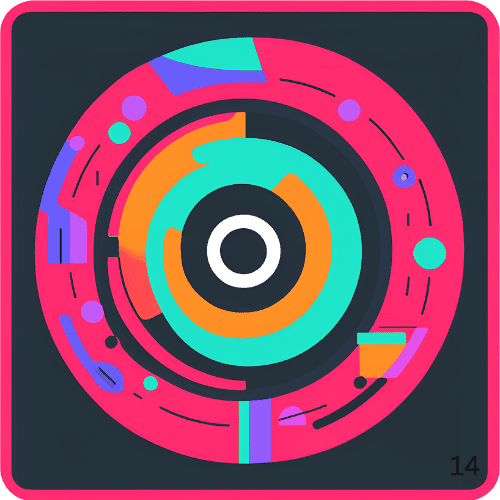Discover the Best AI Tools for HR Professionals that streamline recruitment, employee management, and HR analytics. Transform your workflows with cutting-edge AI solutions.
As an HR pro, I’ve seen how AI is changing the game in workforce management. The digital shift is making HR more strategic and efficient. AI tools are key for making smart decisions.
Gartner says 38% of HR leaders are looking into generative AI for 2024. This shows AI’s big role in HR today. It’s making things like hiring and keeping employees better and easier.
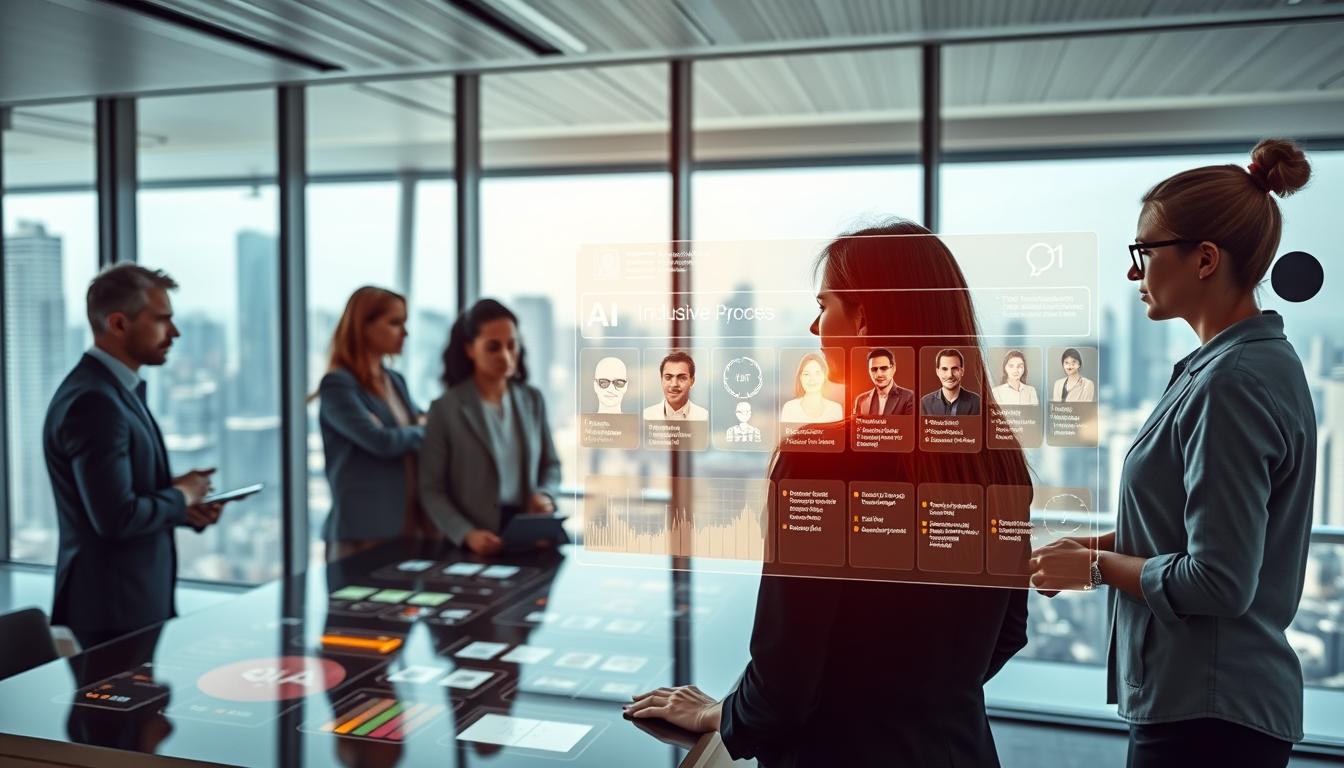
Exploring AI in HR, I found it’s a total game changer for managing talent. These tools do more than just automate tasks. They make workplaces smarter and more effective, leading to success.
Key Takeaways
- AI is revolutionizing HR technology with intelligent, data-driven solutions
- 38% of HR leaders are actively implementing AI tools in 2024
- AI-powered HR tools enhance decision-making and operational efficiency
- Cutting-edge technologies are transforming recruitment and talent management
- Embracing AI is crucial for staying competitive in modern HR practices
Understanding AI’s Role in Modern HR Operations
The world of human resources is changing fast, thanks to artificial intelligence and digital innovation. As an HR pro, I’ve seen how AI is changing talent management, making processes smoother, and helping us make better decisions.
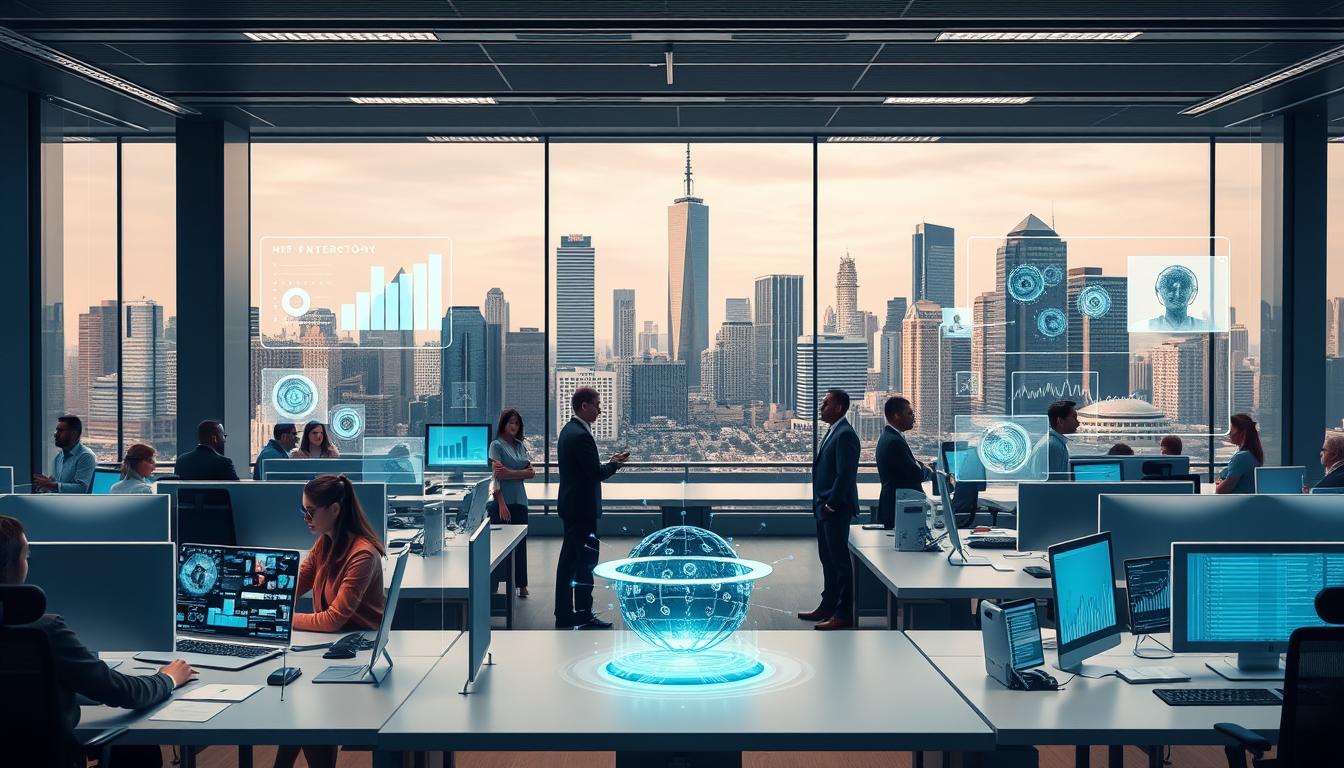
Digital transformation in HR is happening now, not just in the future. AI is making old HR tasks more efficient, data-driven, and strategic.
The Evolution of HR Technology
HR automation has changed how we manage the workforce. From old paper work to AI-powered platforms, the change is huge:
- 1990s: Basic digital record-keeping systems
- 2000s: Cloud-based HR management software
- 2010s: Initial AI-powered recruitment tools
- 2020s: Comprehensive AI-driven HR ecosystems
Key Benefits of AI in HR Management
AI brings big benefits to organizations:
| AI HR Benefit | Impact |
|---|---|
| Process Automation | Reduces administrative workload by 40-60% |
| Candidate Screening | Improves recruitment efficiency by 75% |
| Predictive Analytics | Enhances workforce planning accuracy |
Current AI Adoption Trends in HR
A McKinsey survey found that 50% of companies cut HR costs by 20% or more with AI. This shows AI’s big impact on HR.
AI is not replacing human resources professionals—it’s empowering them to become more strategic and impactful.
Impact of AI Tools on HR Efficiency and Productivity
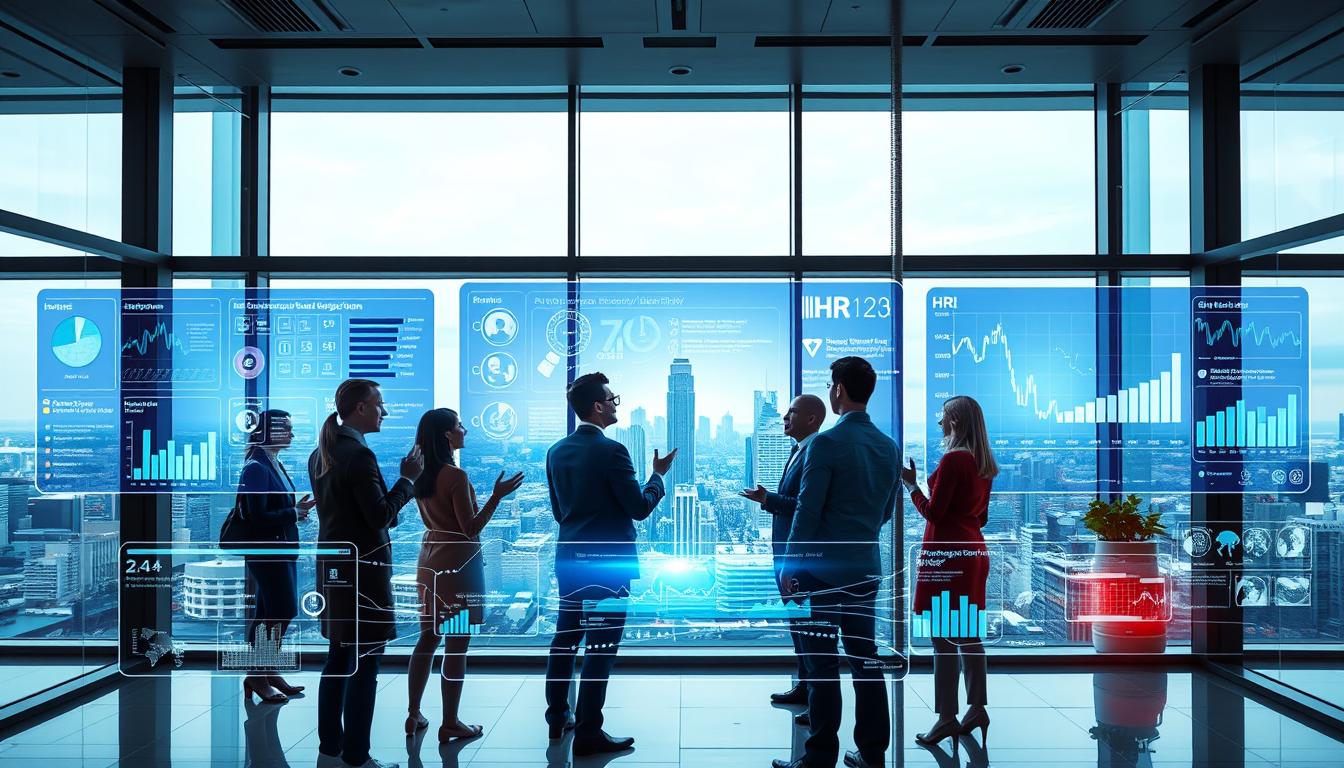
AI is changing HR by making work better. It helps people do more important tasks, not just the usual stuff. This makes work more efficient and enjoyable.
The biggest changes AI brings to HR are:
- Automating boring tasks
- Helping make better decisions with data
- Lowering mistakes in important HR jobs
- Making hiring and managing talent faster
Here’s how AI boosts HR work:
| HR Function | AI Impact | Productivity Gain |
|---|---|---|
| Recruitment | Resume screening | 70% time reduction |
| Employee Onboarding | Automated documentation | 50% process acceleration |
| Performance Management | Predictive analytics | 40% improved insights |
AI tools are not just making things better—they’re changing how HR works. They use smart tech to help HR focus on big picture stuff, not just day-to-day tasks.
Companies using AI in HR see big wins. They get better performance, happier employees, and smarter plans for the future.
Essential Features of AI-Powered HR Tools
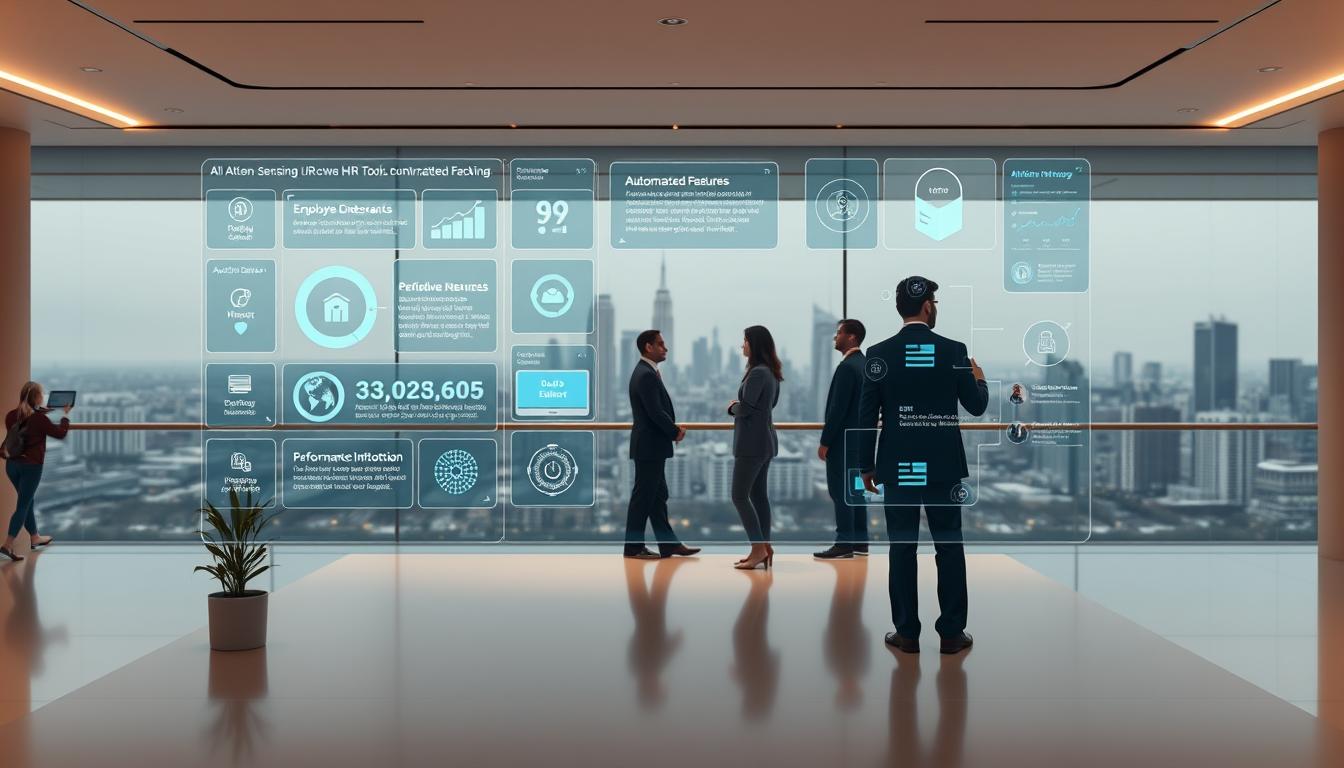
AI is changing how companies manage their teams. As an HR pro, I’ve seen how AI tools make work easier. They automate tasks, freeing up time for more important work.
Today’s AI HR tools have features that boost work efficiency. Here are the main points that make them so useful:
Automation Capabilities
At the heart of AI tools is HR task automation. They can do repetitive tasks quickly and accurately:
- Instant resume screening and candidate filtering
- Automated interview scheduling
- Employee query management through intelligent chatbots
- Routine paperwork processing
Data Analytics and Reporting
AI tools turn data into useful insights. They offer:
- Real-time performance analytics
- Predictive workforce trend identification
- Comprehensive talent management reports
- Customizable dashboard visualizations
Integration Requirements
Good AI HR tools integrate well with other systems. Look for ones that:
- Connect with existing HR management systems
- Synchronize data across multiple platforms
- Ensure secure and compliant data transfers
- Provide scalable solutions for growing organizations
With these features, HR can focus on big-picture tasks. AI takes care of the detailed, time-consuming work.
Best AI Tools for HR Professionals
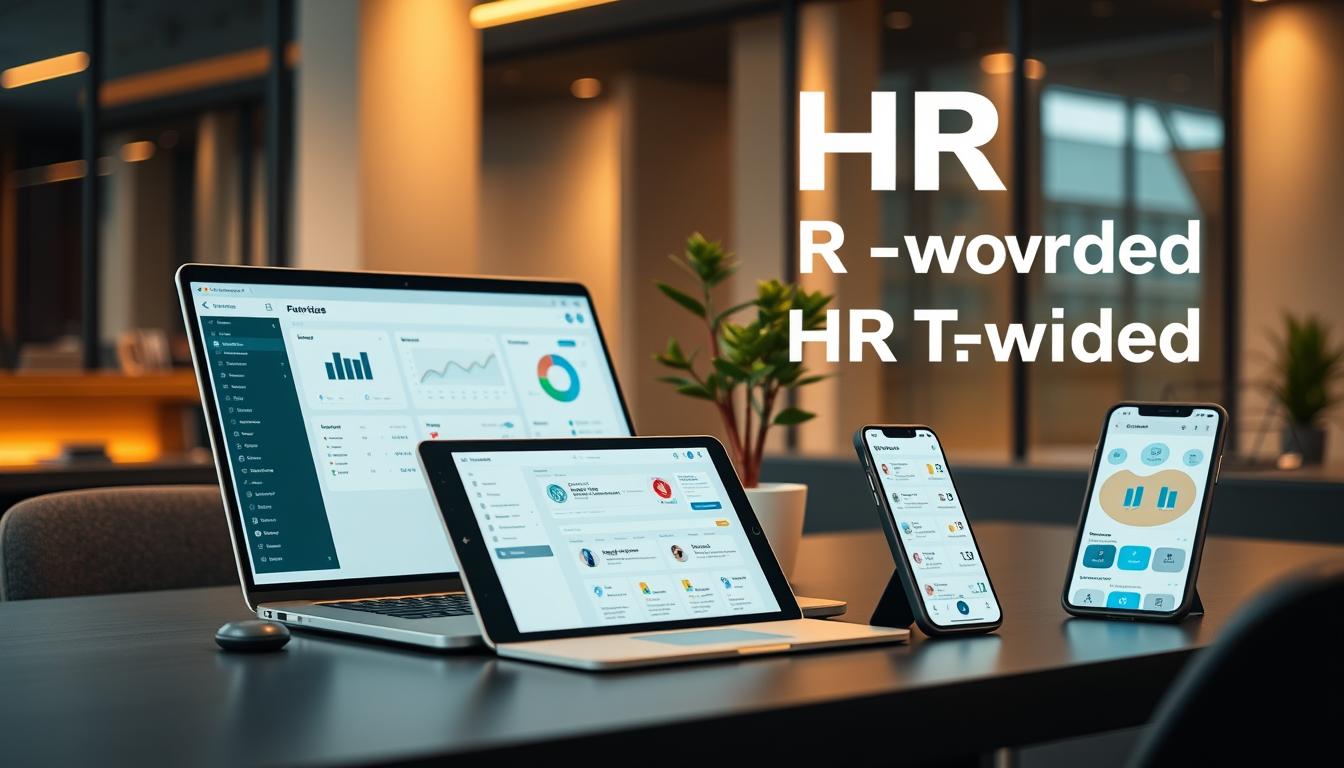
Exploring AI software for HR can be daunting. I’ve gathered a detailed list of the best HR AI tools. These tools can greatly improve your HR department’s efficiency and strategy.
The right AI tools can change how HR handles recruitment, employee management, and growth. Here are some key solutions that are reshaping HR technology.
- Recruitment AI Tools
- Ideal for screening candidates
- Automated resume parsing
- Bias reduction in hiring processes
- Performance Management Solutions
- Real-time feedback tracking
- Predictive performance analytics
- Personalized development recommendations
I’ve put together a comparison of leading AI software for HR. This should help you choose wisely:
| Tool Name | Primary Function | Key Features | Price Range |
|---|---|---|---|
| Workday | Workforce Management | AI-powered recruitment, analytics | $25-$100/user monthly |
| Greenhouse | Recruitment Optimization | Candidate screening, interview scheduling | $30-$80/user monthly |
| BambooHR | Employee Management | Performance tracking, onboarding | $20-$60/user monthly |
When picking the best HR AI tools, think about your company’s needs, budget, and how well they integrate. The right AI software for HR can greatly boost your team’s productivity and strategic impact.
AI Solutions for Recruitment and Talent Acquisition
In today’s job market, AI has changed how companies find the best talent. Recruitment tech is making hiring faster and more based on data.

The world of finding talent has changed a lot with smart tech. AI tools help HR teams check candidates faster with advanced screening.
Resume Screening Tools
AI resume screening tools use smart algorithms to quickly look over applications. They can:
- Understand complex resume formats
- Find important skills and experiences
- Compare candidates to job needs
- Lessen bias in first checks
Candidate Assessment Platforms
Automated platforms for picking candidates do more than just look at resumes. They use machine learning to guess a candidate’s fit by looking at:
- Behavioral tests
- Technical skill checks
- How well they fit the company culture
- How likely they are to do well
Interview Management Systems
AI interview systems offer new ways to manage interviews. They use video analysis, track feelings, and evaluate candidates in real-time. This helps companies make better choices and hire faster.
By using AI for resume screening and picking candidates, companies can make their hiring process better, faster, and more insightful.
Employee Engagement and Performance Management Tools
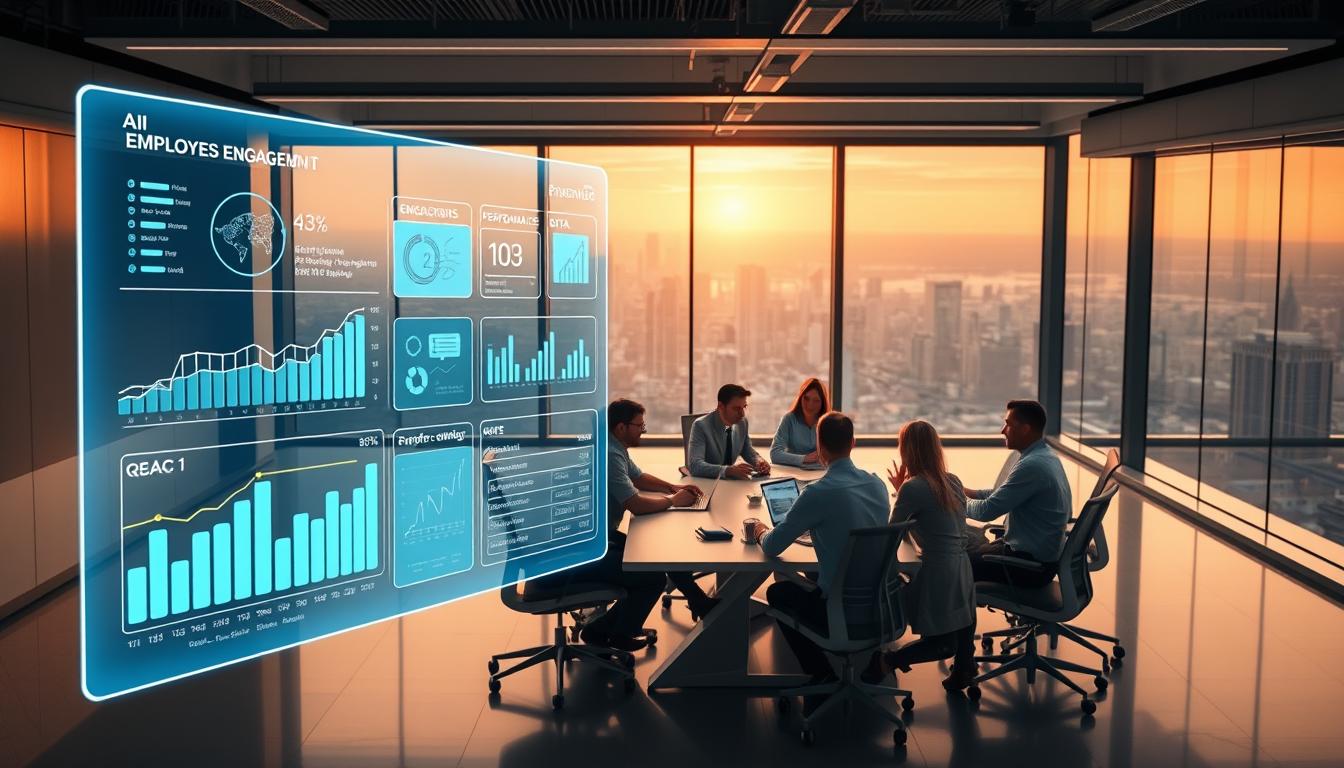
Modern workplaces are changing fast thanks to AI in performance management software. These tools are changing how we see and care for our employees.
AI employee engagement platforms give us new insights into the workplace. They use advanced analytics and machine learning. This gives us feedback that’s more than just annual reviews.
- Continuous performance tracking
- Real-time sentiment analysis
- Predictive engagement metrics
- Personalized development recommendations
Platforms like Culture Amp and Lattice show how AI can change the game. Their smart algorithms can:
- Detect early signs of burnout
- Find talent with great potential
- Give managers insights to act on
- Make plans for growth
Using AI tools, companies can make workplaces that grow with each person. They focus on both personal and team success.
“AI is not replacing human interaction, but enhancing our ability to understand and support our workforce.” – HR Technology Expert
The future of work is all about data, personal touch, and constant improvement. AI is making this future a reality. It brings transparency and support to both employees and leaders.
AI-Powered Learning and Development Platforms
The world of corporate training is changing fast with AI. Now, learning is smarter and more tailored to each person. This makes training more effective and engaging for everyone.

Today’s AI learning tools offer a new level of personalization and speed. They look at each employee’s skills, how they learn, and what they want to achieve. Then, they create learning paths just for them.
Personalized Learning Solutions
AI makes it possible for companies to give each employee a unique learning experience. Some key features include:
- Dynamic content recommendation
- Real-time skill assessment
- Adaptive learning modules
- Personalized progress tracking
Skill Gap Analysis Tools
Top training platforms also do deep skill gap analysis. They help find out:
- What skills the team already has
- Where they need to grow
- Best ways to improve skills
- How to help each person learn more
Training Content Generation
AI can now make training content on its own. This saves time and makes learning more effective.
| Platform Feature | Benefit | Impact |
|---|---|---|
| AI Content Creation | Personalized Learning Materials | 50% Faster Development |
| Adaptive Assessment | Targeted Skill Improvement | 35% Performance Increase |
| Real-time Tracking | Continuous Learning Insights | 40% Higher Engagement |
Investing in AI-powered learning platforms is a smart move for the digital age.
Workforce Analytics and Planning Solutions
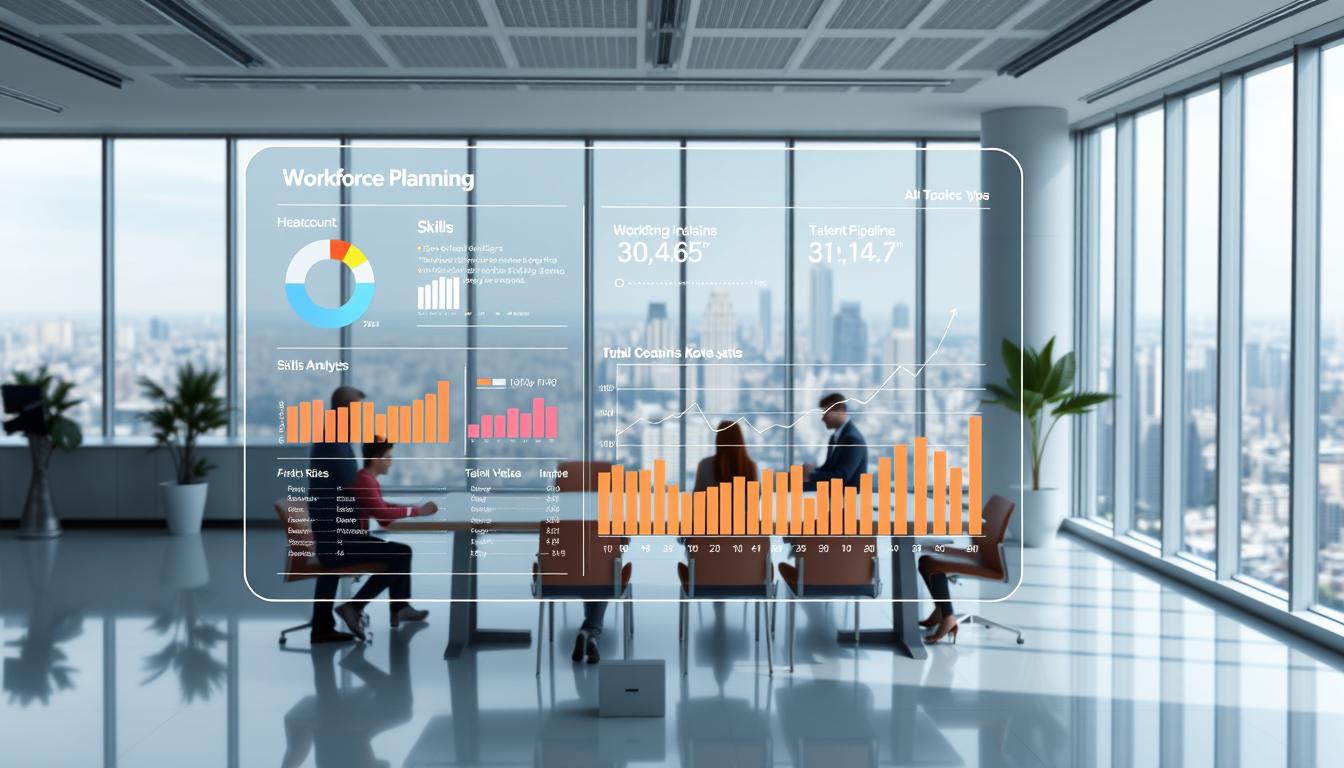
In today’s fast-changing business world, AI workforce planning is a big deal for HR pros. Predictive HR analytics change how companies manage talent. They give insights into the workforce like never before.
Modern AI workforce analytics solutions bring big changes to strategic planning:
- Real-time workforce trend analysis
- Predictive skill gap identification
- Strategic talent forecasting
- Performance optimization recommendations
Companies using advanced predictive HR analytics see big improvements in their talent strategy. Tools like Visier use artificial intelligence to build detailed workforce models. This helps HR teams make decisions based on solid data.
The main benefits of AI workforce planning are:
- Proactive talent acquisition strategies
- Reduced recruitment costs
- Enhanced employee retention predictions
- Personalized workforce development plans
By using advanced AI algorithms, companies can predict workforce needs months or even years ahead. This turns HR from a reactive role to a strategic business partner.
“AI-driven workforce analytics are not just a trend—they’re the future of intelligent human resource management.”
HR Compliance and Risk Management Tools
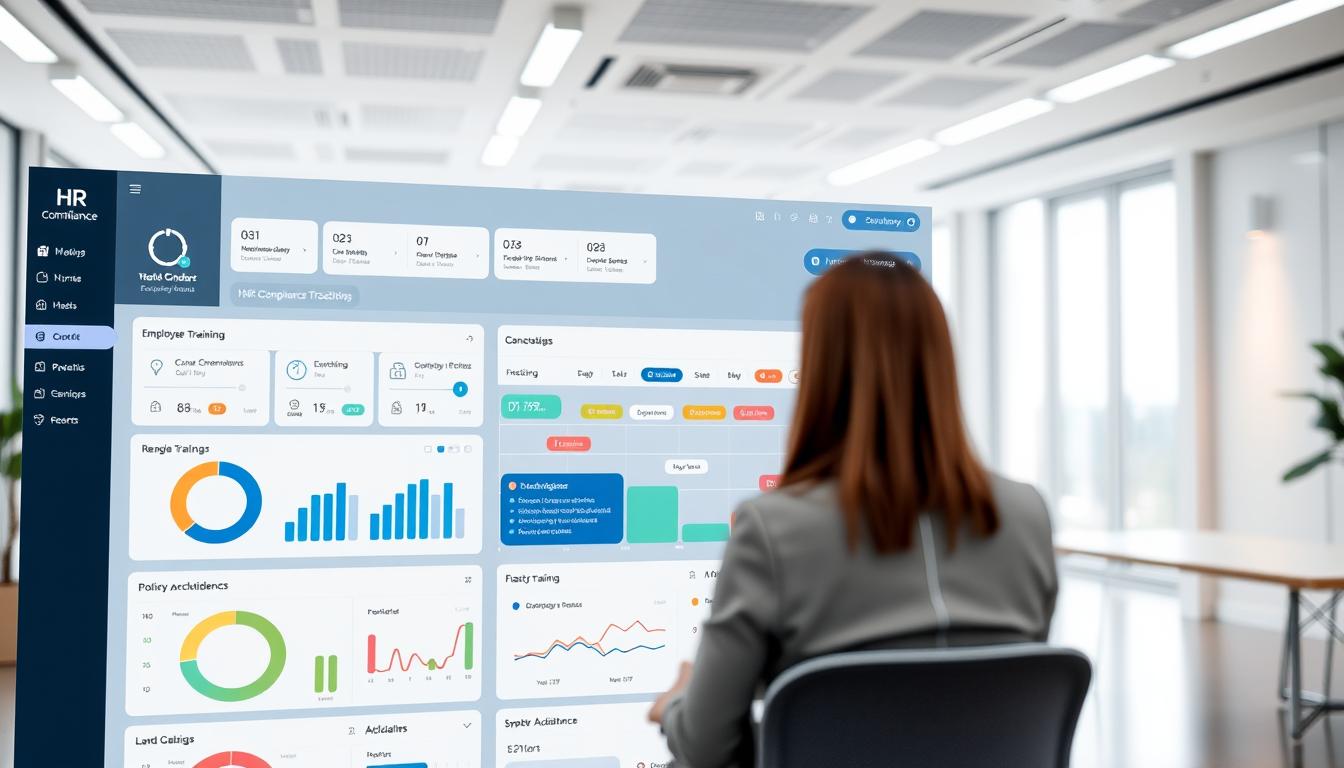
HR professionals face a tough challenge in the complex world of regulatory compliance. AI has changed how companies handle legal and regulatory rules. Automated HR risk management tools are key for businesses wanting to avoid legal issues.
Cutting-Edge Compliance Monitoring
AI-powered tools offer top-notch protection and insights. They have advanced monitoring features. These help HR teams:
- Track regulatory changes in real-time
- Automatically update policy documents
- Identify potential compliance risks before they escalate
- Generate detailed compliance reports
Advanced Policy Management Solutions
AI tools make policy management smarter. XpertHR is a standout for personalizing dashboards and offering AI help for HR questions. It keeps companies ahead of compliance challenges.
Comprehensive Risk Assessment
Automated HR risk management does more than just monitor. It analyzes data to create detailed risk profiles. This helps in making proactive decisions and planning the workforce.
“AI compliance tracking is not just a trend—it’s the future of intelligent HR management.”
HR professionals can turn compliance into a strategic advantage with these cutting-edge technologies.
Employee Wellness and Support Platforms

The world of employee mental health tools is changing fast with AI. I’ve seen how these new platforms are making work places better. They offer mental health help that fits each person’s needs.
Today’s AI wellness programs use advanced tech to help employees. They do more than just offer help. They provide:
- Real-time mental health chatbot support
- Personalized wellness recommendations
- Machine learning-driven stress management techniques
- Adaptive meditation and mindfulness exercises
Companies like Headspace and Wysa are at the forefront. They use AI to give each person a unique wellness plan. This makes their platforms stand out.
| AI Wellness Platform | Key Features | Target Support |
|---|---|---|
| Headspace | Meditation guidance, therapy recommendations | Stress reduction, mental resilience |
| Wysa | AI-powered therapy chatbot | Emotional support, mental health tracking |
These AI wellness programs do more than just help individuals. They also benefit the workplace as a whole. By using smart mental health tools, companies can:
- Reduce workplace stress
- Improve employee productivity
- Lower healthcare costs
- Create a more supportive work environment
As AI keeps getting better, employee mental health tools will too. They’ll offer even more tailored and effective support.
AI Tools for Compensation and Benefits Management
In today’s job market, AI in compensation management is a big deal for HR folks. I’ve seen how new tech changes salary planning and benefits handling.

AI salary benchmarking has changed how companies set pay. These smart tools use machine learning for quick, accurate salary info. This helps companies make smart pay decisions.
Salary Analysis Platforms
Today’s AI salary tools are amazing:
- They analyze pay for different jobs automatically.
- They compare salaries in real time.
- They predict future salaries.
- They spot pay gaps.
Benefits Administration Systems
AI in benefits makes complex tasks easier. It helps design unique benefits packages. This attracts and keeps the best workers while keeping costs down.
Equity Management Tools
AI equity tools ensure fair pay. They check pay data, find pay gaps, and suggest fixes. This helps make workplaces fair for everyone.
The future of pay management is smart, data-based, and fair for all.
If you’re in HR, check out AI tools for pay and benefits. They can change how your company handles pay and benefits.
Integration Considerations for HR AI Tools

Choosing AI tools for HR is more than just looking at features. It’s about how well they fit with your current systems. You need to make sure the AI tools work well with your existing technology.
When you’re ready to add AI to your HR, focus on a few important steps:
- Check out your current HR tech setup
- See if the AI tools can connect through APIs
- Make sure they can move and sync data smoothly
- Check if they meet security and compliance standards
For AI tools to work well together, you need a solid plan. It’s not just about linking systems—it’s about making everything work together smoothly. The AI tools should easily connect with your HRIS, payroll, and talent management systems.
“Integration is the bridge between potential and performance in HR technology.” – Tech Innovation Expert
Work closely with your IT team when picking AI tools. They can spot any integration issues and help make sure the new tools work right.
Look for tools that integrate well and cut down on manual work. The right approach makes AI tools part of a strong, connected team for managing your workforce.
Implementing AI Tools in Your HR Department

Adding AI tools to your HR team is a big step. It needs careful planning and execution. It’s about making sure the change goes smoothly and benefits everyone.
To start using AI well, you need a clear plan. You must know what your team needs. The journey has many important steps that can affect success.
Change Management Strategies
Managing HR tech changes well involves several steps:
- Create a detailed communication plan to explain AI tool benefits
- Address potential staff concerns proactively
- Develop a phased implementation approach
- Establish cross-departmental support teams
Training Requirements
Good training is key for handling HR tech changes. I suggest a training program with different levels:
- Basic AI tool orientation sessions
- Role-specific deep-dive workshops
- Continuous learning opportunities
- Hands-on practice environments
Success Metrics
To see how AI is working, you need clear goals. Important metrics include:
- User adoption rates
- Efficiency improvements
- Cost savings
- Employee satisfaction scores
Remember, successful AI implementation is not just about technology, but about people and processes working together seamlessly.
Future Trends in HR AI Technology

The world of HR tech is changing fast. As an HR pro, I see how AI is changing how we manage work and make big decisions.
AI in HR is set to bring big changes:
- Predictive workforce analytics that guess talent needs
- Hyper-personalized employee experience platforms
- AI-driven organizational design and culture management
- Ethical AI implementation strategies
Generative AI is changing HR for the better. Intelligent systems will likely move beyond administrative tasks to offer insights on talent, engagement, and planning.
Some key trends include:
- Advanced predictive analytics for recruitment
- Real-time skill gap identification
- Automated personalized learning pathways
- Enhanced diversity and inclusion algorithms
These tech advances bring both excitement and the need for ethics. Companies must balance tech with human values to keep trust in AI HR solutions.
The future of HR technology isn’t about replacing human expertise, but augmenting it with intelligent insights.
As AI grows, HR pros must stay flexible and keep learning. They need to use these advanced tools to make workplaces more dynamic and responsive.
Conclusion
The future of HR technology is changing fast. By 2024, almost 38% of HR leaders will use generative AI tools. This shows a big change in how companies handle their people.
The shift to AI in HR is not just about new tech. It’s about changing how we manage our teams. AI helps in hiring, keeping employees happy, and more. It gives HR pros a chance to focus on big goals, not just paperwork.
To use AI well, take a careful, planned approach. First, find out where AI can really help. Then, pick tools that fit your company’s values and goals. Remember, tech works best when it helps people, not replaces them.
Looking ahead, keeping up with new AI is key. The future holds tools that can guess what the workforce will need, make work personal, and make workplaces smarter. By using these new tools wisely, HR can lead the way in making workplaces better.
FAQs
What are the primary benefits of using AI tools in HR?
AI tools in HR make work more efficient. They automate routine tasks and help make better decisions. They also improve candidate screening and offer personalized experiences for employees.These tools provide valuable data insights. This helps in managing the workforce and planning strategically.
Are AI tools expensive for small to medium-sized businesses?
AI tools are now more affordable for small businesses. Many offer scalable solutions. This means you can start with a basic package and grow as needed.Some tools even have free trials or freemium models. This lets companies try out AI capabilities without a big upfront cost.
How do AI tools address potential bias in recruitment?
Advanced AI tools have features to reduce bias. They use algorithms that focus on skills and qualifications. This helps avoid unconscious bias in hiring.These tools standardize screening processes. They also use diverse training data for fair candidate evaluations.
Can AI tools integrate with existing HR management systems?
Yes, most AI HR tools can integrate with popular HR platforms. They have robust API capabilities and integration features. This ensures smooth data transfer and compatibility with existing systems.
What kind of data security measures do AI HR tools have?
Reputable AI HR tools have strong security measures. They use end-to-end encryption, multi-factor authentication, and follow GDPR standards. They also conduct regular security audits.These tools protect sensitive employee information. They maintain strict privacy standards.
How quickly can an organization implement AI HR tools?
The time it takes to implement AI HR tools varies. It depends on the tool’s complexity and the organization’s systems. Some tools can start within weeks, while others might take 2-3 months.Successful implementation requires careful planning and staff training. A phased rollout strategy is often used.
Are AI tools replacing human HR professionals?
No, AI tools are meant to support HR professionals, not replace them. They handle repetitive tasks and provide insights. This frees up HR teams to focus on strategic initiatives and complex decisions.These decisions require human empathy and judgment.
How accurate are AI-powered workforce analytics?
AI workforce analytics are very accurate, often over 85-90%. They analyze data and use machine learning algorithms. This provides reliable predictions about employee performance and skill needs.
What kind of training is required to use AI HR tools?
Most AI HR tools are easy to use, requiring little technical knowledge. Organizations provide training to help HR professionals understand the tools.They learn how to use features, interpret analytics, and maximize the platform’s potential. Many vendors offer onboarding and support resources.
Can AI tools help with remote workforce management?
Yes! AI tools are great for managing remote workforces. They track employee engagement, monitor performance, and analyze communication. They also offer personalized remote learning programs.This helps keep productivity and connection high in distributed teams.

